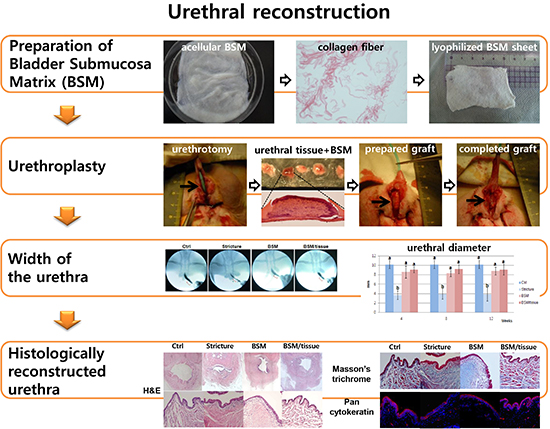1. Sievert KD, Selent-Stier C, Wiedemann J, Greiner TO, Amend B, Stenzl A, Feil G, Seibold J. Introducing a large animal model to create urethral stricture similar to human stricture disease: a comparative experimental microscopic study. J Urol. 2012; 187:1101–1109.
2. Fiala R, Vidlar A, Vrtal R, Belej K, Student V. Porcine small intestinal submucosa graft for repair of anterior urethral strictures. Eur Urol. 2007; 51:1702–1708.
3. Kropp BP, Sawyer BD, Shannon HE, Rippy MK, Badylak SF, Adams MC, Keating MA, Rink RC, Thor KB. Characterization of small intestinal submucosa regenerated canine detrusor: assessment of reinnervation, in vitro compliance and contractility. J Urol. 1996; 156:599–607.
4. Kropp BP, Ludlow JK, Spicer D, Rippy MK, Badylak SF, Adams MC, Keating MA, Rink RC, Birhle R, Thor KB. Rabbit urethral regeneration using small intestinal submucosa onlay grafts. Urology. 1998; 52:138–142.
5. Badylak SF, Vorp DA, Spievack AR, Simmons-Byrd A, Hanke J, Freytes DO, Thapa A, Gilbert TW, Nieponice A. Esophageal reconstruction with ECM and muscle tissue in a dog model. J Surg Res. 2005; 128:87–97.
6. Dahms SE, Piechota HJ, Nunes L, Dahiya R, Lue TF, Tanagho EA. Free ureteral replacement in rats: regeneration of ureteral wall components in the acellular matrix graft. Urology. 1997; 50:818–825.
7. Merguerian PA, Reddy PP, Barrieras DJ, Wilson GJ, Woodhouse K, Bagli DJ, McLorie GA, Khoury AE. Acellular bladder matrix allografts in the regeneration of functional bladders: evaluation of large-segment (> 24 cm) substitution in a porcine model. BJU Int. 2000; 85:894–898.
8. Probst M, Dahiya R, Carrier S, Tanagho EA. Reproduction of functional smooth muscle tissue and partial bladder replacement. Br J Urol. 1997; 79:505–515.
9. Sutherland RS, Baskin LS, Hayward SW, Cunha GR. Regeneration of bladder urothelium, smooth muscle, blood vessels and nerves into an acellular tissue matrix. J Urol. 1996; 156:571–577.
10. Yoo JJ, Meng J, Oberpenning F, Atala A. Bladder augmentation using allogenic bladder submucosa seeded with cells. Urology. 1998; 51:221–225.
11. Zhang Y, Lin HK, Frimberger D, Epstein RB, Kropp BP. Growth of bone marrow stromal cells on small intestinal submucosa: an alternative cell source for tissue engineered bladder. BJU Int. 2005; 96:1120–1125.
12. Chun SY, Lim GJ, Kwon TG, Kwak EK, Kim BW, Atala A, Yoo JJ. Identification and characterization of bioactive factors in bladder submucosa matrix. Biomaterials. 2007; 28:4251–4256.
13. Kim BS, Kim HT, Kwon SY, Chun SY, Choi KH, Park M, Kim DH, Song PH, Kwon TG. Nontransected ventral onlay-augmented urethroplasty using autologous saphenous vein graft in a rabbit model of urethral stricture. Urology. 2014; 83:225–231.
14. Retik AB, Atala A. Complications of hypospadias repair. Urol Clin North Am. 2002; 29:329–339.
15. Freytes DO, Tullius RS, Valentin JE, Stewart-Akers AM, Badylak SF. Hydrated versus lyophilized forms of porcine extracellular matrix derived from the urinary bladder. J Biomed Mater Res A. 2008; 87:862–872.
16. Lorenz C, Maier-Reif K, Back W, Pohl HP, Wang KL. Cultured urothelium in sheep bladder augmentation. Pediatr Surg Int. 1996; 11:456–461.
17. Morrison WA, Webster HR, Kumta S. Urethral reconstruction using the radial artery forearm free flap: conventional and prefabricated. Plast Reconstr Surg. 1996; 97:413–419.
18. Fairbanks JL, Sheldon CA, Khoury AE, Gilbert A, Bove KE. Free bladder mucosal graft biology: unique engraftment characteristics in rabbits. J Urol. 1992; 148:663–666.
19. Jung HS, Kim JW, Lee JN, Kim HT, Yoo ES, Kim BS. Early experience with a thermo-expandable stent (memokath) for the management of recurrent urethral stricture. Korean J Urol. 2013; 54:851–857.
20. Büyükünal SN, Cerrah A, Dervişoğlu S. Appendix interposition in the treatment of severe posterior urethral injuries. J Urol. 1995; 154:840–843.
21. Atala A, Guzman L, Retik AB. A novel inert collagen matrix for hypospadias repair. J Urol. 1999; 162:1148–1151.
22. El-Kassaby AW, Retik AB, Yoo JJ, Atala A. Urethral stricture repair with an off-the-shelf collagen matrix. J Urol. 2003; 169:170–173.
23. Mantovani F, Trinchieri A, Castelnuovo C, Romanò AL, Pisani E. Reconstructive urethroplasty using porcine acellular matrix. Eur Urol. 2003; 44:600–602.
24. Sabbagh W, Masters JR, Duffy PG, Herbage D, Brown RA. In vitro assessment of a collagen sponge for engineering urothelial grafts. Br J Urol. 1998; 82:888–894.
25. Pu LL. Discussion. Improvement of the survival of human autologous fat transplantation by using VEGF-transfected adipose-derived stem cells. Plast Reconstr Surg. 2009; 124:1447–1449.
26. Glotzbach JP, Levi B, Wong VW, Longaker MT, Gurtner GC. The basic science of vascular biology: implications for the practicing surgeon. Plast Reconstr Surg. 2010; 126:1528–1538.
27. Vaos G, Gardikis S, Giatromanolaki A, Kambouri K, Triotapsianis G, Ypsilantis P, Sivridis E, Simopoulos C. Long-term angiogenic activity of free grafts and pedicle flap in a rabbit urethroplasty model. World J Urol. 2013; 31:919–924.
29. De Filippo RE, Yoo JJ, Atala A. Urethral replacement using cell seeded tubularized collagen matrices. J Urol. 2002; 168:1789–1792.








 PDF
PDF ePub
ePub Citation
Citation Print
Print




 XML Download
XML Download